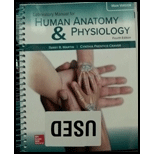
Laboratory Manual For Human Anatomy & Physiology
4th Edition
ISBN: 9781260159080
Author: Martin, Terry R., Prentice-craver, Cynthia
Publisher: Mcgraw-hill Education,
expand_more
expand_more
format_list_bulleted
Textbook Question
Chapter 36, Problem 1.5A
Complete the following
a. What is meant by 20/70 vision?
b. What is meant by 20/10 vision?
c. What visual problem is created by astigmatism?
d. Why does the near point of accommodation often increase the age?
e. Describe the eye defect that causes color-deficient vision.
Expert Solution & Answer
Want to see the full answer?
Check out a sample textbook solution
Students have asked these similar questions
Discuss the possible benefit of
neuroprotective agents such as memantine in
patients with glaucoma.
Use the following information to answer the next question.
Normal Vision
А.
В.
C.
Match each image above with the condition that affects the eye numbered below.
1. Red-green colour blindness
2. Glaucoma
3. Cataracts
4. Astigmatism
5. Macular degeneration
Condition:
Image:
A
В
Describe the common structural defects impairing vision:hyperopia, presbyopia, myopia, astigmatism, amblyopia,and nystagmus.
Chapter 36 Solutions
Laboratory Manual For Human Anatomy & Physiology
Ch. 36 - As a person ages, the elasticity of the lens a....Ch. 36 - Visual acuity is measured using a a. metric ruler....Ch. 36 - Color blindness is a characteristic in of males a....Ch. 36 - The blind spot is located at the of the eye. a....Ch. 36 - Astigmatism results from a defect in the a....Ch. 36 - Only males can inherit the color blindness...Ch. 36 - Nearsightedness is also called myopia. a. True...Ch. 36 - A convex lens can be used to correct hyperopia. a....Ch. 36 - Explain why small objects e not lost from our...Ch. 36 - Complete the following a. What is meant by 20/70...
Knowledge Booster
Learn more about
Need a deep-dive on the concept behind this application? Look no further. Learn more about this topic, biology and related others by exploring similar questions and additional content below.Similar questions
- Madam Ojo, age 60, comes to the eye clinic for a routine eye examination. I. Describe the procedure for checking visual acuity. II. If the ophthalmic nurse records 6/60 for Madam Ojo’s visual acuity, how would you explain this visual acuity score to a first-year nursing student?arrow_forwardWhat is meant by 20/70 vision?arrow_forwardDiscuss how to care for a patient with acute glaucoma.arrow_forward
- What are the DIAGNOSTIC TESTS of SEVERE PREECLAMPSIA? (Expand, explain and enumarate as many as possible) please take note of the word SEVERE. Don't forget citations too.arrow_forwardList the names, actions, possible side effects, and adverse effects of glaucoma drugsarrow_forwardA. Why is the tolerance level of those dealing with children with Acute Otitis Media often low? B. Which disorders are included in extrovert disorders? C. What are the symptoms of children with Acute Otitis Media? d. What is against the fact that Acute Otitis Media has come about because of discomfort or parenting methods?arrow_forward
- Name the eye disorder in which image of the object is formed behind the retina.arrow_forwardWhat are the steps of assisting with ophthalmic medications? Question 5Answer a. Close the client’s door b. Put on gloves c. Clean existing eye drainage if any d. Tilt head forward e. Tilt head back f. Hold eye open with one hand g. Pull eyelid down h. Have client look up i. a. b. d. j. All of the abovearrow_forwardIdentify the following structures of the eyearrow_forward
- Brown-Sequard syndrome is characterized by all the following, except :-a- loss of vibration sense on the opposite side below level of the lesionb- loss of voluntary movements on the same side below the level of the lesionc- loss of reflex movements on the same side at the level of the lesiond- loss of pain sensation on the opposite side below the level of the lesionarrow_forwardName: Year and Section: EXERCISE NO. 21 Physiology of the Special Senses Date Submitted: Group No.:. POST-DISCUSSION QUESTIONS 1. Answer the following prompts: 1. What is photopupillary accommodation reflex? 2. Explain the role of the cochlea in the hearing process. 3. Explain why the common cold is a blockage of olfaction and not of gustation despite the fact that when you have a common cold, you seem to have lost your sense of taste for food (i.e., you became "taste-less").arrow_forwardMake a table of the Brodmann's Area . Give emphasis on the clinical significance and associated functions of each area. Please follow the table below.arrow_forward
arrow_back_ios
SEE MORE QUESTIONS
arrow_forward_ios
Recommended textbooks for you
 Medical Terminology for Health Professions, Spira...Health & NutritionISBN:9781305634350Author:Ann Ehrlich, Carol L. Schroeder, Laura Ehrlich, Katrina A. SchroederPublisher:Cengage Learning
Medical Terminology for Health Professions, Spira...Health & NutritionISBN:9781305634350Author:Ann Ehrlich, Carol L. Schroeder, Laura Ehrlich, Katrina A. SchroederPublisher:Cengage Learning Comprehensive Medical Assisting: Administrative a...NursingISBN:9781305964792Author:Wilburta Q. Lindh, Carol D. Tamparo, Barbara M. Dahl, Julie Morris, Cindy CorreaPublisher:Cengage Learning
Comprehensive Medical Assisting: Administrative a...NursingISBN:9781305964792Author:Wilburta Q. Lindh, Carol D. Tamparo, Barbara M. Dahl, Julie Morris, Cindy CorreaPublisher:Cengage Learning

Medical Terminology for Health Professions, Spira...
Health & Nutrition
ISBN:9781305634350
Author:Ann Ehrlich, Carol L. Schroeder, Laura Ehrlich, Katrina A. Schroeder
Publisher:Cengage Learning

Comprehensive Medical Assisting: Administrative a...
Nursing
ISBN:9781305964792
Author:Wilburta Q. Lindh, Carol D. Tamparo, Barbara M. Dahl, Julie Morris, Cindy Correa
Publisher:Cengage Learning
Visual Perception – How It Works; Author: simpleshow foundation;https://www.youtube.com/watch?v=DU3IiqUWGcU;License: Standard youtube license